Contents
- PM: Rs. 20-lakh-crore Economic Stimulus Package
- India caught in U.S.-China spat over Taiwan’s status
- No violation of air space at Pangong Tso lake: IAF
- FAC on Dibang Valley Project and Amrabad Tiger Reserve
- Govt. identifies sectors for tax sops
- India may miss nutrition targets
- Do numbers matter in Rajya Sabha?
PM: RS. 20-LAKH-CRORE ECONOMIC STIMULUS PACKAGE
Focus: GS-III Disaster Management
Why in news?
The Prime Minister, on 12th May, announced an economic stimulus package for ₹20-lakh-crore (estimated at 10% of the GDP), with a clearly defined leap towards economic reforms that will lead to Atmanirbhar Bharat, or a self-reliant, resilient India.
Details
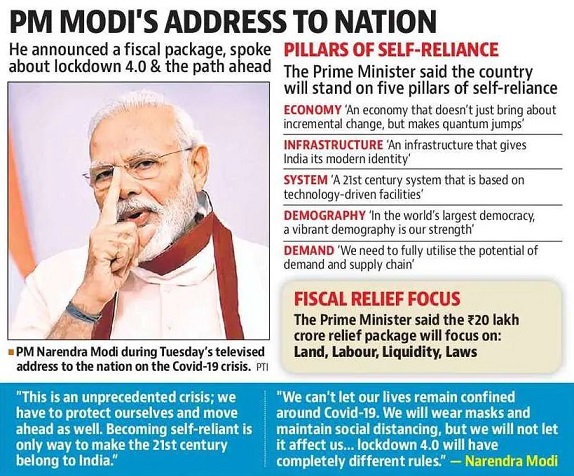
This amount includes packages already announced at the beginning of the lockdown incorporating a slew of measures from the RBI and the payouts under the Pradhan Mantri Garib Kalyan Yojana.
Click Here to read about the “Aatmanirbhar Bharat” Announcement by the PM
-Source: The Hindu
INDIA CAUGHT IN U.S.-CHINA SPAT OVER TAIWAN’S STATUS
Focus: GS-II International Relations, Prelims
Why in news?
As tensions between the U.S. and China rise over the novel coronavirus pandemic, India is faced with a major choice on whether to support a U.S. move to reinstate Taiwan’s observer status at the World Health Assembly (WHA) or to China’s opposition to it.
India is set to take over as the next Chairperson of the World Health Organisation’s decision-making executive body (World Health Assembly – WHA) in May, as India’s nominee will take over as the Chairperson, replacing Japan.
India’s Taiwan Dilemma
- The U.S. has, in the recent past, accused WHO of acting as a “PR agency” for China during the pandemic.
- A seven-nation virtual meeting of Foreign Ministers was convened by U.S. which appeared to be part of Washington’s efforts to gain support for its move to effect changes at the WHO.
- U.S. Senate passed an act to regain observer status for Taiwan in the World Health Organization.
- India is likely to hold the post for the next three years. The timing of the appointment is crucial, given the worldwide debate on the role of the WHO during the pandemic, and criticism of the current WHO Director.
China’s Position on Taiwan
- China has also stepped up warnings on any attempt to include or support Taiwan’s role at the WHA.
- Chine referred to the “One-China” principle as “a widely accepted universal consensus of the international community including the Indian government.”
- China asserts that there is only “One China” and that Taiwan is an inalienable part of it.
- China put forward a formula, known as “one country, two systems”, under which both Beijing and Taipei agree that Taiwan belongs to China, while the two still disagree on which entity is China’s legitimate governing body.
- China also stated its right to use “non-peaceful means” against Taiwan if it tried to secede from China.
India’s Position on Taiwan
- The MEA declined to comment on whether Taiwan was discussed during the meeting, or whether India has decided on supporting the US on its move to include Taiwan as a WHA participant.
- India recognises only the People’s Republic of China (in mainland China) and not the Republic of China’s claims of being the legitimate government of Mainland China, Hong Kong, and Macau – a conflict that emerged after the Chinese Civil War (1945–49).
- The United States, Canada, the United Kingdom, India, Pakistan and Japan have formally adopted the One China policy, under which the People’s Republic of China is theoretically the sole legitimate government of China.
Taiwan
- Taiwan, officially the Republic of China (ROC), is a state in East Asia.
- The island of Taiwan has the People’s Republic of China (PRC) to the north-west, Japan to the north-east, and the Philippines to the south.
- Taipei is the capital of Taiwan.
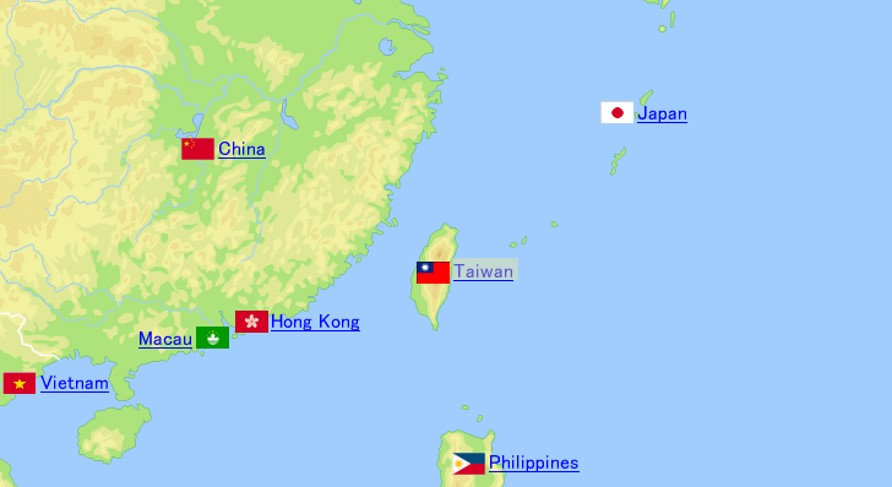
-Source: The Hindu
NO VIOLATION OF AIR SPACE AT PANGONG TSO LAKE: IAF
Focus: GS-I Geography, GS-III Internal Security, Prelims
Why in news?
Helicopters of the Chinese People’s Liberation Army (PLA) came close to the border during the face-off with the Indian Army near Pangong Tso lake in Eastern Ladakh.
As per existing agreements between India and China, operation of fighter aircraft and armed helicopters is restricted to a distance from the LAC.
According to the ‘Agreement on Maintenance of Peace and Tranquillity along the LAC in India-China Border Area’ of 1996, “combat aircraft (to include fighter, bomber, reconnaissance, military trainer, armed helicopter and other armed aircraft) shall not fly within 10 km of the LAC.”
Pangong Tso
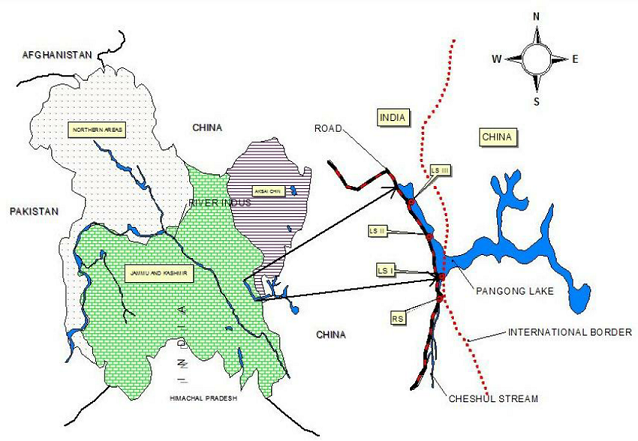
- Pangong Tso or Pangong Lake is an endorheic lake in the Himalayas situated at a height of about 4,350m.
- It is 134 km (83 mi) long and extends from India to the Tibetan Autonomous Region, China.
- Approximately 60% of the length of the lake lies within the Tibetan Autonomous Region.
- It is NOT a part of the Indus river basin area and geographically a separate landlocked river basin.
- The lake is in the process of being identified under the Ramsar Convention as a wetland of international importance.
Extra bits: Endorheic basin
An endorheic basin is a limited drainage basin that normally retains water and allows no outflow to other external bodies of water, such as rivers or oceans, but converges instead into lakes or swamps, permanent or seasonal, that equilibrate through evaporation.
Such a basin may also be referred to as a closed or terminal basin or as an internal drainage system or interior drainage basin.
-Source: The Hindu
FAC ON DIBANG VALLEY PROJECT AND AMRABAD TIGER RESERVE
Focus: GS-III Environment and Ecology, Prelims
Why in news?
The environment ministry’s Forest Advisory Committee (FAC) has deferred its decision on granting forest clearance to:
- Hydropower Project in Arunachal Pradesh’s Dibang Valley
- The exploration of Uranium in Telangana’s Amrabad Tiger Reserve
Details
- An FAC subcommittee report on April 21 recommended that the Etalin Hydroelectric Project, which will involve clearing 270,000 trees, be allowed with a condition that the developer deposits money for wildlife conservation in the area.
- Now, FAC has asked the power ministry to say whether the project is viable in its current form.
- It also directed Arunachal Pradesh to submit a cost-benefit analysis of the project.
- On the uranium exploration in Amrabad Tiger Reserve, FAC has sought a clear view from Telangana.
Forest Advisory Committee (FAC)
- Forest Advisory Committee (FAC) is a Statutory Body under the Ministry of Environment, Forests & Climate Change (MoEF&CC).
- FAC was constituted by the Forest (Conservation) Act, 1980.
- It plays an advisory role in questions on the diversion of forest land for non-forest uses such as mining, industrial projects, townships and advises the government on the issue of granting forest clearances.
Dibang Wildlife Sanctuary
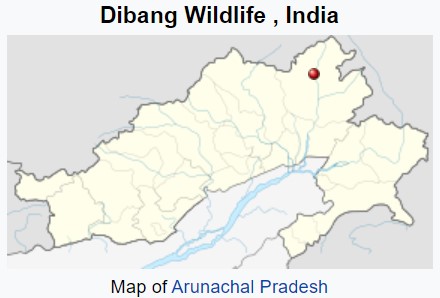
- The Dibang Wildlife Sanctuary is one of the eight wildlife sanctuaries of Arunachal Pradesh, India.
- Dibang Wildlife Sanctuary is located fully or partly within Dihang-Dibang Biosphere Reserve.
- Rare mammals such as Mishmi Takin, Red Goral, Musk Deer (at least two species), red panda, Asiatic black bear, occasional Tiger and Gongshan muntjac occur while among birds there are the rare Sclater’s monal and Blyth’s tragopan.
-Source: Hindustan Times
GOVT. IDENTIFIES SECTORS FOR TAX SOPS
Focus: GS-III Indian Economy
Why in news?
The government has identified close to a dozen sectors, ranging from capital goods, defence, pharma and electronics to labour-intensive ones such as textiles and food where it is considering proposals for tax concessions.
It is also pushing for land and procedural reforms to attract investment as part of a goal to be self-sufficient.
Details
- The government is keen to tap parts of the global supply chain that may want to relocate from China.
- Department for Promotion of Industry and Internal Trade (DPIIT) has made suggestions regarding creation of manufacturing clusters and new models for land leasing and “plug-and-play” facilities to enable businesses to simply invest and begin operations quickly.
- DPIIT has also proposed a tax holiday for sectors, and tax benefits for labour-intensive sectors such as food processing and leather.
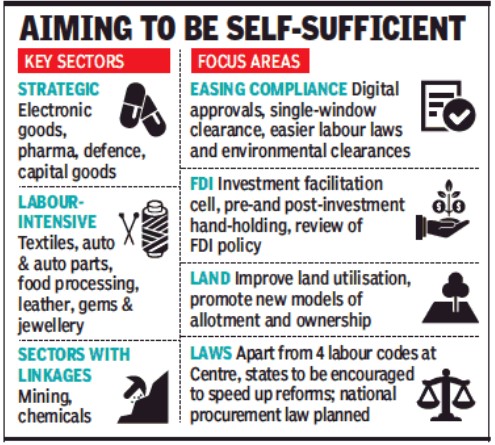
DPIIT
- The Department for Promotion of Industry and Internal Trade (DPIIT) is a central government department under the Ministry of Commerce and Industry.
- It is responsible for formulation and implementation of promotional and developmental measures for growth of the industrial sector, keeping in view the national priorities and socio-economic objectives.
-Source: Times of India
INDIA MAY MISS NUTRITION TARGETS
Focus: GS-II Social Justice
Why in news?
India is among 88 countries that are likely to miss global nutrition targets by 2025, according to the Global Nutrition Report 2020 released on 12th May 2020.
Global Nutrition Targets
In 2012, the World Health Assembly (WHA) identified six nutrition targets for maternal, infant and young child nutrition to be met by 2025.
These require governments to:
- Reduce stunting by 40% in children under 5
- Reduce prevalence of anaemia by 50% among women in the age group of 19-49 years
- Ensure 30% reduction in low-birth weight
- Ensure No increase in childhood overweight
- Increase the rate of exclusive breastfeeding in the first six months up to at least 50%
- Reduce and maintain childhood wasting to less than 5%.
India’s Position in Global Nutrition
India will miss targets for:
- Stunting among under-5 children
- Anaemia among women of reproductive age
- Childhood overweight
- Exclusive breastfeeding.
These are the only 4 nutrition Indicators for which data is available, and India will miss the targets set for all of them!
It also identified the country as one with the highest rates of domestic inequalities in malnutrition.
Reality of nutrition levels in India
- Between 2000 and 2016, rates of underweight have decreased from 66.0% to 58.1% for boys and 54.2% to 50.1% in girls.
- However, this is still high compared to the average of 35.6% for boys and 31.8% for girls in Asia.
- In India 37.9% of children under 5 years are stunted and 20.8% are wasted, compared to the Asia average of 22.7% and 9.4% respectively.
- One in two women of reproductive age is anaemic, while at the same time the rate of overweight and obesity continues to rise.
- India is identified as among the three worst countries, along with Nigeria and Indonesia, for steep within-country disparities on stunting
Causes according to the report
Inequity is a cause of malnutrition — both under-nutrition and overweight, obesity and other diet-related chronic diseases.
Inequities in food and health systems exacerbate inequalities in nutrition outcomes that in turn can lead to more inequity, perpetuating a vicious cycle
-Source: The Hindu
DO NUMBERS MATTER IN RAJYA SABHA?
Focus: GS-II Governance, Polity, Prelims
Lok Sabha and Rajya Sabha: Cooperation in Divergent Composition
- The Indian Constitution provides for parity of powers between the Lok Sabha and the Rajya Sabha in law, making an exception in some cases.
- The Money Bill or Finance Bills can be introduced only in the Lok Sabha which only can approve the Demands for Grants.
- The Rajya Sabha has some special powers such as: Requiring to adopt a resolution allowing Parliament to legislate on subjects in the State List and creating All India Services, approving proclamations of Emergency and President’s Rule when the Lok Sabha is dissolved.
A Comparison of Composition
- Elections to the Lok Sabha are held every five years and before that on dissolution of the House.
- For the Rajya Sabha, one-third of the members are chosen every second year reflecting its permanent nature.
- While the Lok Sabha elections hold a mirror to the recent will of the people, the Rajya Sabha is envisaged to convey the same in different phases of development marking some continuity.
- The Executive lasts only as long as it has a majority in the Lok Sabha, but in law-making, both the Houses are at par.
Divergent: Unlike Lok Sabha
- During the past 68 years since the first general elections in 1952, the elected Government had a majority in the Rajya Sabha only for 29 years and was in a minority for 39 years.
- This pronounced divergence in numbers in the two Houses of Parliament does not indicate any adverse impact on the broader course of legislation except in a few cases.
Joint Sittings
So far, Parliament held only Three Joint Sittings to resolve differences between both the Houses:
- The first instance was in 1961 when the then Nehru government enjoyed a majority in the Rajya Sabha but the Dowry Prohibition Bill, 1959 suffered a defeat.
- In 1978, the Banking Services Commission (Repeal) Bill, 1977 was rejected by the Rajya Sabha.
- In 2002, the Prevention of Terrorism Bill, 2002 could not pass the Rajya Sabha scrutiny.
Rajya Sabha and Obstruction of passing of Bills
- As per the constitutional provisions, the Rajya Sabha at best could hold a Money Bill for 14 days during when it has to return such Bills without or with amendments for the consideration of the Lok Sabha.
- There were occasions when the Rajya Sabha sat over Bills passed by the Lok Sabha for a long time including the Prevention of Corruption Bill, 1987 and the Dock worker (Safety, Health and Welfare) Bill, 1986.
- The Rajya Sabha has also made amendments to several Bills passed by the Lok Sabha and these were accepted in several cases by the other House.
- This goes to prove that numbers in the Rajya Sabha is not an issue as far as law-making is concerned.
Increasing disruptions
- An analysis by the Secretariat revealed that the productivity of the Rajya Sabha till 1997 has been 100% and above and the past 23 years have thrown up a disturbing trend of rising disruptions.
- Productivity fell to 87% during 1998-2004, 76% during 2005-14 and 61% during 2015-19.
- This decline is primarily on account of disruptions forcing cancellation of Question Hour frequently.
- Disruptions also dent the quality of law-making as seen in passing of Bills without discussion sometimes.
- The time share on deliberations under instruments like Short Duration Discussions, Zero Hour, Special Mentions, Discussion on Budgets and working of ministries, Motion of Thanks to President etc., rose to 41.42 % during 2005-2014 and to a high of 46.59% during 2015-19.
Conclusion
- What needs to be addressed by all the stakeholders is that while enabling Rajya Sabha to retain its independence, it should not be seen as ‘disruptive’ as evidenced over the past two decades.
- Political passions should not be the basis of such disruptions, if the perception is that they are.
- The line between obstruction and disruption is very thin and we should guard against it.
- Both the sides of the House have a stake in proper functioning of Rajya Sabha.
-Source: The Hindu




